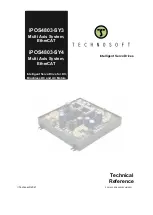
A-1
This Installation Guideline provides handling information and precautions for use of the equipment.
Please forward this Installation Guideline to the end user.
1. Electric Shock Prevention
2. Fire Prevention
3.Injury Prevention
4. Additional Instructions
Also note the following points to prevent an accidental failure,
injury, electric shock, etc.
(1) Transportation and mounting
This section is specifically about safety matters
Do not attempt to install, operate, maintain or inspect the
inverter until you have read through the Installation
Guideline and appended documents carefully and can use
the equipment correctly. Do not use this product until you
have a full knowledge of the equipment, safety information
and instructions.
In this Installation Guideline, the safety instruction levels
are classified into "WARNING" and "CAUTION".
Assumes that incorrect handling may
cause hazardous conditions, resulting
in death or severe injury.
Assumes that incorrect handling may
cause hazardous conditions, resulting
in medium or slight injury, or may
cause physical damage only.
Note that even the
level may lead to a serious
consequence according to conditions. Please follow the
instructions of both levels because they are important to
personnel safety.
z
While power is on or when the inverter is running, do not
open the front cover. Otherwise you may get an electric
shock.
z
Do not run the inverter with the front cover or wiring cover
removed. Otherwise, you may access the exposed high-
voltage terminals or the charging part of the circuitry and
get an electric shock.
z
Even if power is off, do not remove the front cover except
for wiring or periodic inspection. You may access the
charged inverter circuits and get an electric shock.
z
Before starting wiring or inspection, switch off power,
check to make sure that the operation panel indicator is
off, wait for at least 10 minutes after the power supply has
been switched off, and check that there are no residual
voltage using a tester or the like. The capacitor is charged
with high voltage for some time after power off and it is
dangerous.
z
This inverter must be earthed (grounded). Earthing
(grounding) must conform to the requirements of national
and local safety regulations and electrical code. (NEC
section 250, IEC 536 class 1 and other applicable
standards)
z
Any person who is involved in the wiring or inspection of
this equipment should be fully competent to do the work.
z
Always install the inverter before wiring. Otherwise, you
may get an electric shock or be injured.
z
Perform setting dial and key operations with dry hands to
prevent an electric shock. Otherwise you may get an
electric shock.
z
Do not subject the cables to scratches, excessive stress,
heavy loads or pinching. Otherwise, you may get an
electric shock.
z
Do not change the cooling fan while power is on. It is
dangerous to change the cooling fan while power is on.
z
Do not touch the printed circuit board with wet hands.
Otherwise, you may get an electric shock.
z
When measuring the main circuit capacitor capacity, the
DC voltage is applied to the motor for 1s at powering off.
Never touch the motor terminal, etc. right after powering
off to prevent an electric shock.
WARNING
CAUTION
CAUTION
WARNING
z
Install the inverter on a nonflammable wall without holes
(so that nobody can touch the inverter heatsink on the
rear side, etc.). Mounting it to or near combustible
material can cause a fire.
z
If the inverter has become faulty, switch off the inverter
power. A continuous flow of large current could cause a
fire.
z
When using a brake resistor, make up a sequence that will
turn off power when an alarm signal is output. Otherwise,
the brake resistor may excessively overheat due to
damage of the brake transistor and such, causing a fire.
z
Do not connect a resistor directly to the DC ter
and -. This could cause a fire.
z
Apply only the voltage specified in the instruction manual
to each terminal. Otherwise, burst, damage, etc. may occur.
z
Ensure that the cables are connected to the correct
terminals. Otherwise, burst, damage, etc. may occur.
z
Always make sure that polarity is correct to prevent
damage, etc. Otherwise, burst, damage, etc. may occur.
z
While power is on or for some time after power-off, do not
touch the inverter as they will be extremely hot. Doing so
can cause burns.
z
Transport the product using the correct method that
corresponds to the weight. Failure to observe this could
lead to injuries.
z
Do not stack the inverter boxes higher than the number
recommended.
z
Ensure that installation position and material can
withstand the weight of the inverter. Install according to
the information in the instruction manual.
z
Do not install or operate the inverter if it is damaged or
has parts missing.
z
When carrying the inverter, do not hold it by the front
cover or setting dial; it may fall off or fail.
z
Do not stand or rest heavy objects on the product.
z
Check the inverter mounting orientation is correct.
z
Prevent other conductive bodies such as screws and
metal fragments or other flammable substance such as oil
from entering the inverter.
z
As the inverter is a precision instrument, do not drop or
subject it to impact.
z
Use the inverter under the following environmental
conditions: Otherwise, the inverter may be damaged.
∗
1 Temperature applicable for a short time, e.g. in transit.
CAUTION
CAUTION
CAUTION
E
n
vi
ro
n
m
en
t
Surrounding
air
temperature
-10°C to +50°C (non-freezing)
Ambient
humidity
90%RH maximum (non-condensing)
Storage
temperature
-20°C to +65°C *1
Atmosphere Indoors (free from corrosive gas, flammable gas,
oil mist, dust and dirt)
Altitude/
vibration
Maximum 1000m above sea level for standard
operation. After that derate by 3% for every extra
500m up to 2500m (91%) .
5.9m/s
2
or less
D700_EC_Guideline_ib0600352ENG.book 1 ページ 2008年4月10日 木曜日 午後2時6分



































